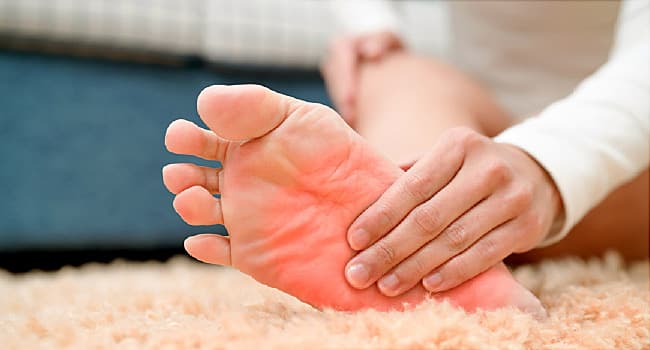Almost half of all people who sprain their ankle once will experience additional ankle sprains and chronic pain, according to the American Orthopaedic Foot and Ankle Society. You can help prevent chronic pain from developing by following these simple steps:
- Follow your doctor’s instructions carefully and complete the prescribed physical rehabilitation program.
- Do not return to activity until cleared by your physician
- When you do return to sports, use an ankle brace rather than taping the ankle. Bracing is more effective than taping in preventing ankle sprains.
- If you wear hi-top shoes, be sure to lace them properly and completely.
Arch Pain
Plantar fasciitis is an inflammation of a thick, fibrous ligament in the arch of the foot called the plantar fascia. The plantar fascia attaches into the heel bone and fans out toward the ball of the foot, attaching into the base of the toes. If this ligament is stretched excessively it will become inflamed and begin to cause pain.
Cortisone injections, used in the treatment of heel pain, are not commonly used for the treatment of plantar fasciitis. The main emphasis of treatment is to reduce the forces that are causing the plantar fascia to stretch excessively. This includes calf muscle stretching, over the counter arch supports, and orthotics. Oral anti-inflammatory medications may be useful in controlling the pain.
Arthritis
Arthritis can be treated in many ways, including:
- Physical therapy and exercise
- Orthoses or specially prescribed shoes
- Foot soaks/paraffin baths
- Ice packs
- Massages
- Over-the-counter anti-inflammatory medications such as Advil, Tylenol, and Aspirin are good medications that � supply relief.
- Prescription non-steroidal anti-inflammatory medications
- Vitamins B6, B12 and folic acid combined in the Rodex Forte capsules also help in the treatment of arthritis.
Ball of the Foot Pain
Treatment of calluses on the balls of your feet consists of periodic trimming or shaving the callous, padding the shoes to remove the pressure, functional shoe orthotics, or surgery.
Pain in the ball of the foot not associated with calluses can be a result of inflammation of a tendon into the toe, inflammation of the joint, or due to a pinched nerve called a Neuroma. A neuroma will also often cause a burning pain into one or more toes.. Another cause of pain in the ball of the foot is arthritis. Treatments include orthoses (shoe inserts) and/or cortisone injections, but surgical removal of the growth is sometimes necessary.
Arthritis will usually affect multiple joints in the ball of the foot. Common types of arthritis are rheumatoid arthritis, osteoarthritis and degenerative arthritis. Degenerative arthritis most commonly affects the big toe joint. Arthritis can be treated in many ways, including:
- Physical therapy and exercise
- Medication
- Orthoses or specially prescribed shoes
The big toe joint is often stiff causing jamming (Hallux Limitus). Over time the jamming of the joint will cause an enlargement on the top of the joint. Anti-inflammatory medications, cortisone injections and/or functional orthotics are some of the common treatments for stiff big toe.
Surgery may be prescribed if spurring around the joint becomes severe.
The most common cause of pain in the ball of the foot, in the area of the big toe joint, is sesamoiditis. Sesamoiditis is an inflammation of two small bones under the big toe joint. On occasion, a stress fracture can occur in one of these bones. Severe pain with sudden onset about the big toe joint may be gout. Sesamoiditis can be relieved with proper shoe selection and orthoses.
Bunions
Most bunions can be treated without surgery by wearing protective pads to cushion the painful area, and of course, avoiding ill-fitting shoes in the first place.
Bunion surgery, or bunionectomy, realigns the bone, ligaments, tendons and nerves so your big toe can be brought back to its correct position. Many bunion surgeries are performed on a same-day basis (no hospital stay) using an ankle-block anesthesia. A long recovery is common and may include persistent swelling and stiffness.
Heel Pain
Plantar fasciitis (or heel pain) is commonly traced to an inflammation on the bottom of the foot. A podiatric physician can evaluate arch pain, and may prescribe customized shoe inserts called orthoses to help alleviate the pain.
Also called “heel spur syndrome,” the condition can usually be successfully treated with conservative measures such as use of anti-inflammatory medications and ice packs, stretching exercises, orthotic devices, and physical therapy.
Metatarsalgia
Foot pain in the “ball of your foot,” the area between your arch and the toes, is generally called metatarsalgia. The pain usually centers on one or more of the five bones (metatarsals) in this mid-portion of the foot, according to the American Orthopaedic Foot and Ankle Society.
Also known as “dropped metatarsal heads,” metatarsalgia can cause abnormal weight distribution due to over pronation.
A simple change shoes may solve the problem. In more severe cases, podiatrists may prescribe full-length custom-molded foot orthoses.
Top of the Foot Pain
There are several causes of pain on the top of the foot. The type of pain and its location help the doctor in determining the cause of the pain and helps to direct them in the best treatment.
Managing pain on the top of the foot can be aided by:
- A limitation of activity
- Below the knee walking casts
- Functional orthotics
- Oral anti-inflammatory medications

